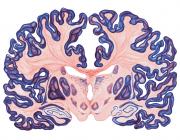Functional organization of human posterior parietal cortex: grasping- and reaching-related activations relative to topographically organized cortex.
Publication Year
2013
Type
Journal Article
Abstract
The act of reaching to grasp an object requires the coordination between transporting the arm and shaping the hand. Neurophysiological, neuroimaging, neuroanatomic, and neuropsychological studies in macaque monkeys and humans suggest that the neural networks underlying grasping and reaching acts are at least partially separable within the posterior parietal cortex (PPC). To better understand how these neural networks have evolved in primates, we characterized the relationship between grasping- and reaching-related responses and topographically organized areas of the human intraparietal sulcus (IPS) using functional MRI. Grasping-specific activation was localized to the left anterior IPS, partially overlapping with the most anterior topographic regions and extending into the postcentral sulcus. Reaching-specific activation was localized to the left precuneus and superior parietal lobule, partially overlapping with the medial aspects of the more posterior topographic regions. Although the majority of activity within the topographic regions of the IPS was nonspecific with respect to movement type, we found evidence for a functional gradient of specificity for reaching and grasping movements spanning posterior-medial to anterior-lateral PPC. In contrast to the macaque monkey, grasp- and reach-specific activations were largely located outside of the human IPS.
Keywords
Journal
J Neurophysiol
Volume
109
Pages
2897-908
Date Published
06/2013
ISSN Number
1522-1598
Alternate Journal
J. Neurophysiol.
PMID
23515795

